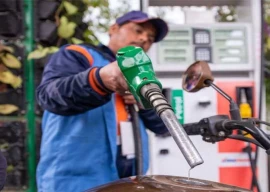
KARACHI:
Consider yourself in the shoes of a CEO of an industrial unit looking to improve output of its production process; it could either be done by increasing inputs or by cleverly thinking of ways to increase the output with the same level of input.
Economic literature is rife with studies which have dissected economic growth and fundamental inputs of the production process – labour and capital.
Economist Dr Moses Abramovitz studying the American economy from 1870 to 1950 found that measured growth in inputs of labour and capital could only explain 15% of growth in output of the economy. Nobel Prize winning economist Robert Solow, who worked on a different time period using a varying methodology, also found the residual close to a significant 85% not explained by growth in inputs.
Economists were then led to believe that technological advancement is a key factor in output growth in the major industrialised nations.
Technological advancement has a crucial role to play in driving overall productivity upwards and is pivotal for economic prosperity. In four broad areas of the economy, namely energy, transportation and industrial machinery, logistics and communication, the technological advancement has a beneficial impact on the macro economy and contributes to improving a nation’s standard of living.
In this article, I delve into energy and industrial machinery in the context of Pakistan.
Energy shortage is one of its most pressing economic challenges. The energy deficit results in the creation of a mountain of circular debt, bank borrowing and subsequent high fiscal deficits.
There has been a policy emphasis in recent years to increase power generation. In Pakistan, the generation mix relies almost 64% on the more expensive thermal sources using oil, gas and coal as inputs. Amongst these, oil is the most used input accounting for 61.9% in the thermal generation mix. This raises the need for oil imports to supplement the domestic sources.
According to the Pakistan Bureau of Statistics, the country’s imports totalled almost $41 billion in FY15, of which a large component comprised oil and the petroleum sector.
With growing net consumption of oil coupled with flat production and limited refining capacity, the country remains heavily dependent on petroleum product imports. Any advancement in the existing structure to meet energy needs could potentially result in reducing the oil import burden and would result in considerable savings of foreign exchange.
Technological advancement
Pakistan has seven refineries that processed 11.8 million tons of oil equivalent in FY14. Recent technological advancement at Pakistan Refinery Limited, which has a share of 13.9% in total processing of crude oil, through the installation of a new isomerisation plant is set to double the refinery’s annual petrol output from 140,000 to 280,000 tons.
This is the first modular plant of UOP/Honeywell, USA in Pakistan. The state-of-the-art plant was built in the UAE and shipped to Karachi for on-site installation. With meticulous planning and team work, the startup was achieved ahead of schedule.
The entire EPC (engineering, procurement and construction) phase took 20 months, whereas the typical timeframe for conventional plants of this size is around 26-30 months. It is interesting to note that this upgrading of petrol refining capacity has come after a passage of 60 years.
Pakistan Refinery Limited CEO Aftab Hussain said, “This technological advancement is a big achievement in terms of foreign exchange savings to the tune of $12-14 million.
“Initially, we used to export naphtha – a low value-added product – to Fujairah, UAE where it was converted to petrol (a high value-added product) and then it was imported by Pakistan after paying a premium of $100-125 per ton. The increase in refining capacity of this plant would provide a sustainable supply to the local market which is already in deficit.”
Indeed, steps like this taken in the private sector would go a long way towards developing the country’s economy.
Dr Abramovitz, in his famous Catch-Up Growth Hypothesis, essentially stated that the key to the economic growth experienced by Western Europe was its ability to import and adopt technology from the United States. Any effort at improving the existing technological framework of an industry, which is involved in essential services, has wide-ranging positive externalities in many different sectors of the economy.
The writer is an economist and ex-central banker
Published in The Express Tribune, July 27th, 2015.
Like Business on Facebook, follow @TribuneBiz on Twitter to stay informed and join in the conversation.




















_updates1713245447-0/1178596_7858743_Salman-Khan-(2)_updates1713245447-0-270x192.webp)

























COMMENTS
Comments are moderated and generally will be posted if they are on-topic and not abusive.
For more information, please see our Comments FAQ